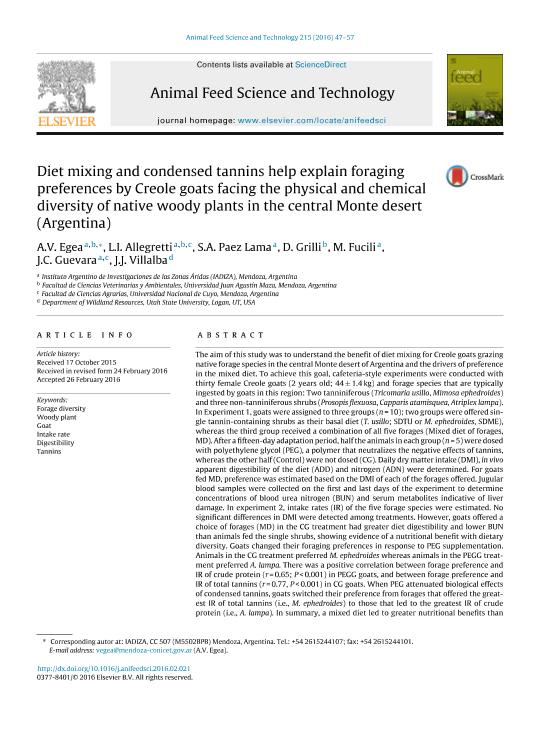Artículo
Diet mixing and condensed tannins help explain foraging preferences by Creole goats facing the physical and chemical diversity of native woody plants in the central Monte desert (Argentina)
Egea, Angela Vanina ; Allegretti, Liliana Inés; Paez Lama, Sebastián Antonio
; Allegretti, Liliana Inés; Paez Lama, Sebastián Antonio ; Grilli, Diego Javier
; Grilli, Diego Javier ; Fucili, Mercedes
; Fucili, Mercedes ; Guevara, Juan Carlos
; Guevara, Juan Carlos ; Villalba, J. J.
; Villalba, J. J.
 ; Allegretti, Liliana Inés; Paez Lama, Sebastián Antonio
; Allegretti, Liliana Inés; Paez Lama, Sebastián Antonio ; Grilli, Diego Javier
; Grilli, Diego Javier ; Fucili, Mercedes
; Fucili, Mercedes ; Guevara, Juan Carlos
; Guevara, Juan Carlos ; Villalba, J. J.
; Villalba, J. J.
Fecha de publicación:
05/2016
Editorial:
Elsevier Science
Revista:
Animal Feed Science and Technology
ISSN:
0377-8401
Idioma:
Inglés
Tipo de recurso:
Artículo publicado
Clasificación temática:
Resumen
The aim of this study was to understand Creole goats´ preference for native forage species in the central Monte desert of Argentina. To achieve this goal, cafeteria-style experiments were conducted with thirty female Creole goats (2 years old; 44 ± 1.4 kg) which were offered five woody forage species goats typically ingest in this region: Two tanniniferous (Tricomaria usillo, Mimosa ephedroides) and three non-tanniniferous shrubs (Prosopis flexuosa, Capparis atamisquea, Atriplex lampa). In Experiment 1, goats were assigned to three groups (n = 10); two groups were offered single tannin-containing shrubs as their basal diet (T. usillo; SDTU or M. ephedroides, SDME), whereas the third group received a combination of all five forages (Mixed diet of forages, MD). After a fifteen-day adaptation period, half the animals in each group (n=5) were dosed with polyethylene glycol (PEG), a polymer that neutralizes the negative effects of tannins, whereas the other half (Control) were not dosed (CG). Daily dry matter intake (DMI) and in vivo apparent digestibility of the diet (ADD) and nitrogen (ADN) was determined. For goats fed MD, preference was estimated based on the DMI of each of the forages offered. Jugular blood samples were collected on the last day of the experiment to determine concentrations of blood urea nitrogen (BUN) and serum metabolites indicative of liver damage. In experiment 2, intake rates (IR) of the five forage species were estimated. No significant differences in DMI were detected among treatments. However, goats offered a choice of forages (MD) in the CG treatment had greater diet digestibility and lower BUN than animals fed the single shrubs, showing evidence of a nutritional benefit with dietary diversity. Goats changed their forage preference in response to PEG supplementation. Animals in the CG treatment preferred M. ephedroides whereas animals in the PEGG treatment preferred A. lampa. There was a positive correlation between forage preference and IR of crude protein (r = 0.65; P < 0.001) in PEGG goats, and between forage preference and IR of total tannins (r = 0.77, P < 0.001) in CG goats. When biological effects of condensed tannins were attenuated by PEG goats switched their preference from forages which offered the greatest IR of total tannins (i.e., M. ephedroides) to those which led to the greatest IR of crude protein (i.e., A. lampa). In summary, a mixed diet led to greater nutritional benefits than single diets which contribute to explain the diverse array of food items goats typically show when browsing in the central Monte desert of Argentina. Our results also show that CP, tannins and plant structure (which offer variable intake rates) play significant roles in goats´ foraging preferences in this environment.
Palabras clave:
Woody Plant
,
Goat
,
Intake Rate
,
Digestibility
,
Tannins
,
Digestibility
Archivos asociados
Licencia
Identificadores
Colecciones
Articulos(IADIZA)
Articulos de INST. ARG DE INVEST. DE LAS ZONAS ARIDAS
Articulos de INST. ARG DE INVEST. DE LAS ZONAS ARIDAS
Articulos(IHEM)
Articulos de INST. HISTOLOGIA Y EMBRIOLOGIA DE MEND DR.M.BURGOS
Articulos de INST. HISTOLOGIA Y EMBRIOLOGIA DE MEND DR.M.BURGOS
Citación
Egea, Angela Vanina; Allegretti, Liliana Inés; Paez Lama, Sebastián Antonio; Grilli, Diego Javier; Fucili, Mercedes; et al.; Diet mixing and condensed tannins help explain foraging preferences by Creole goats facing the physical and chemical diversity of native woody plants in the central Monte desert (Argentina); Elsevier Science; Animal Feed Science and Technology; 215; 5-2016; 47-57
Compartir
Altmétricas



